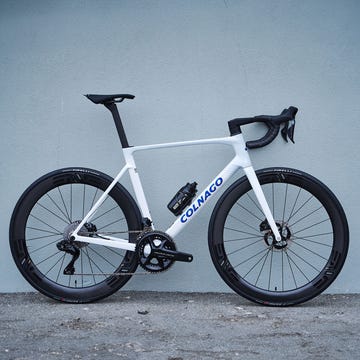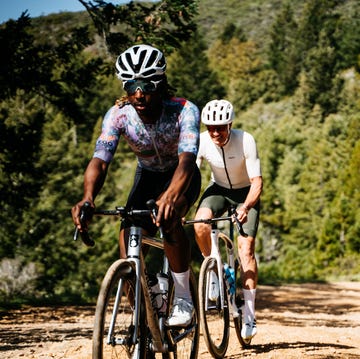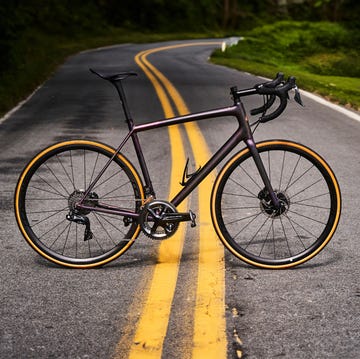“Gravel shoes” are a thing—Scare quotes because the whole concept of gravel shoes confounds me.
I am not alone. Recently, I was chatting with someone at a shoe brand about this category, and they asked me, “How is it different than a cross country mountain bike shoe?”
That is an excellent question. Candidly, the difference seems more about having the right look—a uniform—than about equipment that functions differently.
Unfortunately, opinions about what does and does not constitute the correct uniform or the proper equipment to use in a certain situation become the unwritten rules you should follow to be considered a real cyclist.
Cycling has many dumb, unwritten rules. A few examples: Only world champions should have world champion stripes on their clothing or equipment; Your helmet and shoes should be the same color; White bar tape is only okay if you also have a white saddle; Tire hot patches must be aligned with the valve stem; White shorts and a dark-colored jersey are never okay.
The unwritten rules regarding sock and shoe color coordination, eyewear temples over or under helmet straps, and just how high a cycling cap should sit on the head are downright byzantine.
Cycling’s unwritten rules are stupid, but the fashion rules are especially stupid. Unfortunately, some unwritten rules have become written rules.
The UCI enacted rules in 2008 banning tight-fitting clothing in DH racing. A handful of downhill pros (and clothing companies with investments in DH riders) championed these rules because they didn’t like the increasing popularity of skinsuits.
Some downhillers were racing with skinsuits at the time because they were (and still are) more aerodynamic than loose-fit clothes. It was pure function: more aerodynamic clothing, faster speeds, quicker times. But some pros were upset because they thought the skinsuits didn’t look cool.
Here’s a quote from Rachel Atherton from when the rules were enacted. She was commenting on the skinsuit her rival Tracy Moseley used in competition, “Fair enough to Tracy if she wants to do that to win, but for the sport and the longevity of the sport, to wear cool race kit and to make an image for yourself is more important than the odd win here and there.”
In 2023, the UCI slightly revised its downhill clothing regulations, but the skinsuit ban remains.
The downhill clothing regulations are dumb because they were created only to force all riders to wear uniforms that conform to the aesthetic tastes of a few image-conscious pros and clothing brands.
But even outside the bounds of racing regulations, cycling has surprisingly rigid unwritten rules that try to force us to use specific gear and conform to a particular look. Every kind of cycling has a uniform, and the rules around them are powerful.
Don’t believe me? Try showing up at a serious road group ride in Ripton riding jeans and see what kind of comments you get. Show up at the Whistler Bike Park lift line in a Visma | Lease a Bike Kit, and you will get looks.
The pressure to get us to conform to separate uniform rules for different ways of riding a bike manifests in some odd product distinctions.
Helmets: If it has a visor, it is a mountain bike helmet; no visor and bright colors, it’s a road bike helmet; no visor and earth-tone colors, it’s a gravel helmet; round and smooth and painted in a neutral color and it becomes an “urban” helmet.
Consider rain jackets: Hood and a looser fit, mountain; no hood and tighter fit, road.
It’s not that there aren’t functional differences. A tighter-fitting jacket without a hood is more aerodynamic and packs slightly smaller than a looser-fitting jacket with a hood. But those differences are about polishing the edges for slight differences in function and significant differences in aesthetics.
If it’s raining and cold and I need a jacket to protect myself, it does not matter if I wear a “mountain” jacket on my road bike. However, the unwritten uniform rules say that I should own two rain jackets: one for mountain biking and one for road biking.
So we have gravel shoes. These are mountain bike shoes called something different, pitched as part of a gravel uniform.
In product presentations, marketing people argue that a gravel shoe is different from an XC shoe because the gravel shoe provides less protection around the toe and forefoot area, does not have toe-spike threads, and uses lighter upper materials.
These minor differences do not change the big picture: marketing is the most significant difference between gravel and mountain bike shoes.
I’ve worn many “gravel” shoes for mountain biking, and they worked great. I’ve also used gravel shoes for cyclocross, and, again, they were great. And I’ve used XC race shoes for gravel riding and road riding.
And just to throw a wrinkle in the distinctions brands create to try and sell us stuff we don’t need, a popular trend among pro gravel racers is using road shoes and pedals in gravel races.
It turns out that a good shoe—or jacket, or helmet, or jersey—is good no matter where and how you use it. Follow or ignore the rules: All that matters is that you’re happy and comfortable because you’re using good gear.

A gear editor for his entire career, Matt’s journey to becoming a leading cycling tech journalist started in 1995, and he’s been at it ever since; likely riding more cycling equipment than anyone on the planet along the way. Previous to his time with Bicycling, Matt worked in bike shops as a service manager, mechanic, and sales person. Based in Durango, Colorado, he enjoys riding and testing any and all kinds of bikes, so you’re just as likely to see him on a road bike dressed in Lycra at a Tuesday night worlds ride as you are to find him dressed in a full face helmet and pads riding a bike park on an enduro bike. He doesn’t race often, but he’s game for anything; having entered road races, criteriums, trials competitions, dual slalom, downhill races, enduros, stage races, short track, time trials, and gran fondos. Next up on his to-do list: a multi day bikepacking trip, and an e-bike race.
















